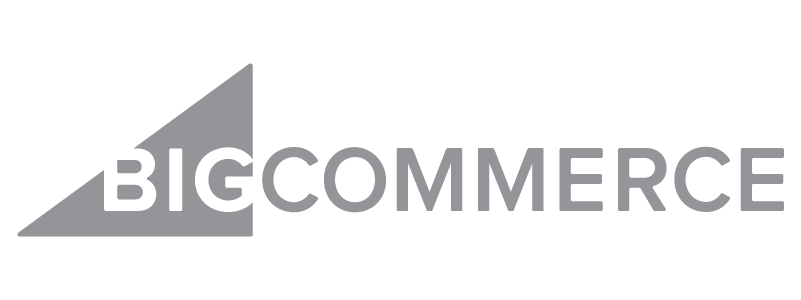After you’ve spent months or even years developing a product or service, it may seem like getting that first customer is the easy part. The truth is, it can be more challenging to get your first sale than you may realize.
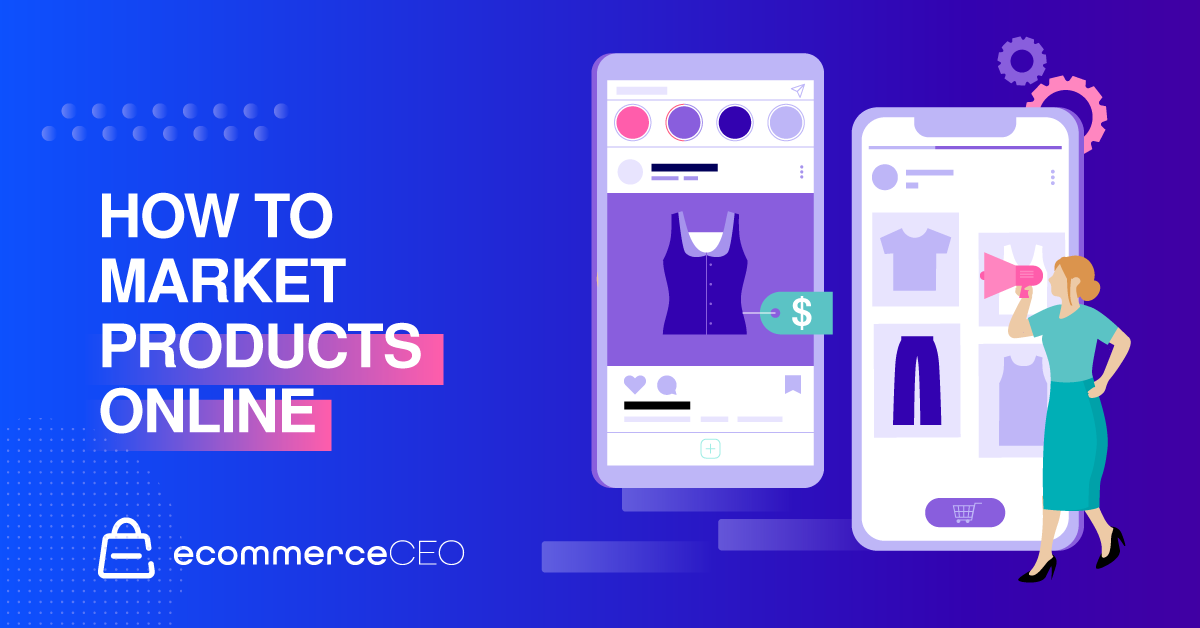
That’s why we will show you how to market products online with 25 proven ways to get that ball rolling.
How to Market Products Online
It takes money to make money in your ecommerce business. You need funds to invest in marketing and promotion until it brings revenue. For some business owners, every dime goes into building the online store, meaning that marketing has to be done on a shoestring budget. If that’s you – fear not – many of the options on this list are free or low-cost. You can reinvest in your online marketing budget to speed up growth as you start making sales.
Learn How to Dominate the Search Engines with Search Engine Optimization (SEO)
SEO involves multiple things, and trying to master it all at once will overwhelm you. But, that shouldn’t stop you from getting started with it and learning more as you go.
Start with putting yourself in the customer’s shoes. What does your target audience think about products? How do they talk about them? What do they want to know?
Conduct some keyword research to find out what people are searching for related to what you’re offering.
SEO is what helps bring in organic traffic from the search engines. To make a good impression on your site visitors, provide valuable information for people throughout all stages of the buyer’s journey.
Inform and Educate with a Blog
If you’ve not already started a blog on your website, you’re missing out on the chance to capitalize on free traffic from search engines.
Treat each blog post as an opportunity to bring in more traffic from Google search results, but more importantly, as a way to provide value to your target audience.
Use that keyword list we just talked about as the basis for ideas for blog content.
As you craft blog content, optimize it for a specific keyword (and a couple of related secondary keywords) and focus on on-page SEO. Pay attention to search volume, as this can give you an idea of how much traffic you can expect from a high-ranking post. This includes:
- Including the keyword in your page and post titles
- Writing an enticing meta description that includes your keyword. Your readers will see the meta description before clicking on the post, so it’s best to have a call to action.
- Including the keyword where appropriate in the content
- Optimizing your image ALT text
- Link to other pages on your site where appropriate for further information.
- Link to external sites where appropriate to provide value to your readers.
Use your blog to frequently share company news, tutorials, tips, and other resources related to your products and the lifestyle around them.
Share it on your social media channels whenever you post a new blog on your site.
Reach People at the Right Time with Email Marketing
Research shows that for every $1 you spend on email marketing, you’ll earn $42 in return. With a 4,200% return, there’s no reason not to invest in email marketing.
Starting an email list means that you have contact information for your audience – whether they are current or prospective customers. You can reach them in their email boxes and have a direct connection to them.
Encourage sign-ups to your email list by offering a coupon or discount. For example, you could follow Kohl’s lead and offer a 15% discount on the next order. Or, you could use a discount wheel so your prospects can “spin to win” a discount or free shipping.
You can segment your email marketing list into prospective customers and existing customers. This helps to personalize your messaging so that each marketing campaign is targeted to the right segment.
Other ecommerce marketing methods, like sharing on social media, are not likely to reach your entire audience because social media algorithms only show your content to a small percentage of your followers.
Collaborate with Influencers to Build Brand Awareness
Influencers aren’t limited to celebrities. You can find bloggers, entrepreneurs, and journalists in your niche to work with. The size of their audience is important but shouldn’t be the only deciding factor about who you work with.
The engagement rate is what really matters. These influencers often have massive followings on social media, composed of the same people you’re trying to reach. But if those followers aren’t engaged with the influencer, then what they share about you will fall on deaf ears.
Tools like Phlanx’s engagement rate calculator are available to help you check an Instagram account.
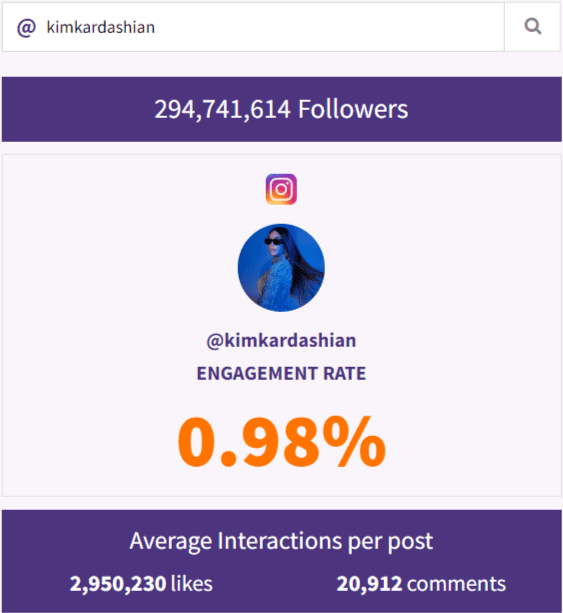
We see that Kim Kardashian has nearly 300 million followers but only gets 2.9 million likes and 21K comments. That’s an engagement of less than 1%.
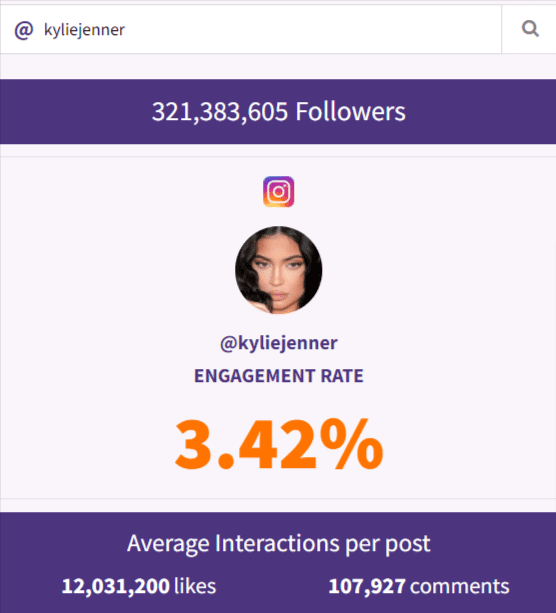
Now let’s look at her sister, Kylie Jenner. She has more followers, at about 320 million. She gets an average of 12 million likes and 108K comments per post, putting her engagement rate much higher – at 3.42%.
More people interact with Kylie’s posts, which you’re looking for when working with influencers.
There are many ways you can run influencer marketing campaigns, from social media takeovers to sponsored blog posts, free samples, product reviews, and more.
Expand Your Reach by Sponsoring Events
Events are a great way to get your name out there and connect with potential customers. You can sponsor virtual or in-person events that make the most sense for you and your brand. The key is making sure the events align.
If you’re a bakery, it won’t make sense to sponsor health and fitness-related events – unless, of course, you’ve managed to craft a tasty treat that’s good for you, too.
Connect with Your Audience on Social Media
Social media platforms like Facebook, Instagram, TikTok, and Pinterest are great ways to connect with people.
For the greatest chance of success with social media marketing, don’t try to be everywhere at once. Instead, go where you know your customers are.
Research the demographics of your audience alongside the demographics of each social channel.
Orberlo’s updated report indicates that as of 2023, the majority of Instagram’s audience falls between 18 and 34 years old. If you’re not focusing your efforts on Millennials or Gen Z, investing in Instagram marketing may not generate a high return on investment (ROI.)
Statistica found that Facebooks biggest demographic is men between the ages of 25 and 34.
Instagram, TikTok, and Pinterest are visual platforms that give you a chance to showcase your brand differently from Facebook. Use these to highlight your manufacturing process and products through images and video. Tell a story about your brand and who you are. Use these Instagram marketing tips to help you get started.
Become an Authority in Your Industry
When you’re seen as an authority in your industry, there’s trust and credibility you can leverage to reach new customers.
You can use a few things on this list, such as blogging and building relationships with influencers, as part of your overall strategy to become an industry authority.
Other things you can do are:
- Guest post on industry publications
- Keep your LinkedIn profile up to date and interact with people there.
- Pitch yourself to relevant podcasts for guest appearances.
- Host online courses and workshops.
- Answer relevant press queries from Help a Reporter Out.
Drive Quality Traffic with Google Ads
Google Ads, formerly known as AdWords, is Google’s pay-per-click (PPC) advertising network. It’s how advertisers can place ads on Google’s search engine results page for nearly any query, partner website in the Google Display Network, and YouTube video.
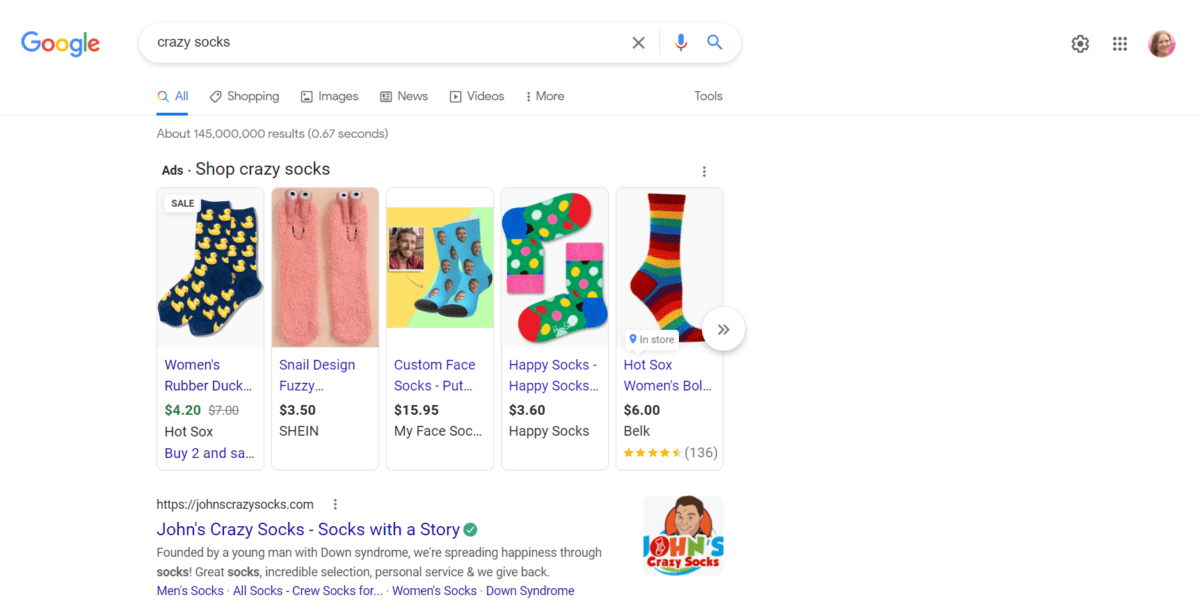
A search for “crazy socks” reveals a series of ads at the top to help you start shopping for your favorite crazy socks right away.
You can get the ads up and running within minutes, with massive reach. You can use text, images, or video ads with your advertising campaign.
With targeting options, you can develop campaigns targeted to display during searches for specific keywords. Your ads will also display on articles and websites that feature similar keywords.
Reach a Targeted Audience with Social Media Ads
Consider using social media ads to grow your social following, drive sales, and drive website traffic.
You can run them on a PPC basis, just like you would with Google Ads. You can set up various campaigns based on your goals and the network you’re on.
With Facebook and Instagram, you can run ads through the Meta for Business platform – choosing to run ads on either or both networks. You can set goals to increase your followers, drive traffic to your website, and increase sales by selling directly on social media.
Twitter, Pinterest, TikTok, and even LinkedIn all have their own advertising platforms, too.
Build a Sales Team with Affiliate Marketing
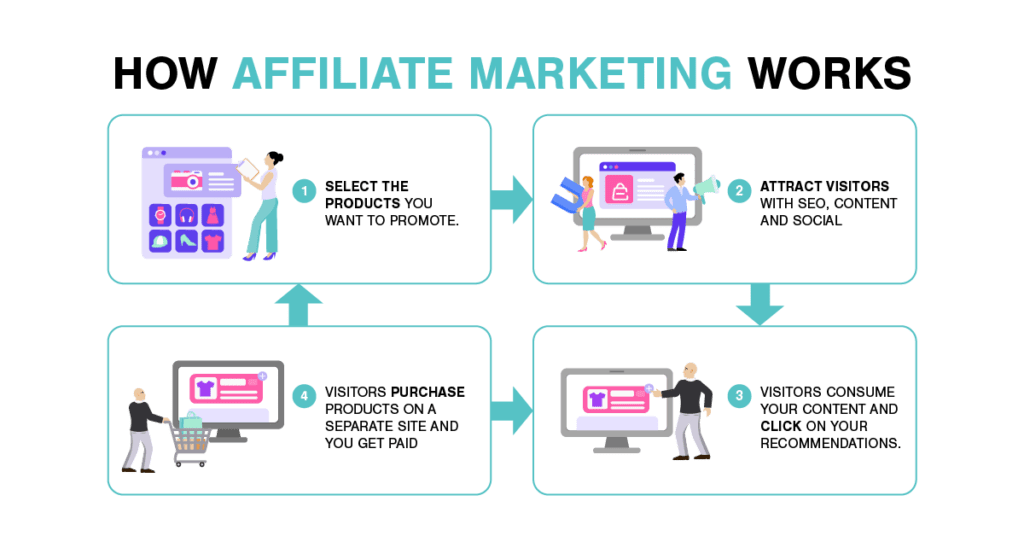
Affiliate marketing means you allow others to market your products and services. When they make a sale, you give them a percentage of the revenue.
People sign up for your affiliate program and promote your product with a unique coupon code or tracking link.
To learn more about how to create a successful affiliate program, check out our post on ecommerce affiliate marketing.
Improve Brand Remarketing Campaigns
Have you ever visited a website, then, within a day or two, seen an ad for that very same website while browsing Facebook or other websites? Or maybe you shopped, left some items in your cart, and then started seeing ads for those same items? You’ve been retargeted.
Remarketing, also known as retargeting, is a popular and highly effective form of digital marketing. Marketers like yourself use ad campaigns to target people who’ve visited your website and taken (or not taken) a specific action.
It’s a great way to target those who have already shown interest in your brand, as the neuromarketing principle says that it takes at least ten interactions with a brand before someone makes a purchase.
Build Trust and Credibility with Video Marketing
Wyzeowl’s State of the Video Marketing survey shows that people watch videos online more than ever before, with 91% of people saying they want to see more online videos from brands in 2023. It also found that 89% of people saying watching a video convinced them to buy a product or service.
So how can you get started with video marketing efforts?
Viewers want new content regularly, so it’s a good idea to create a posting schedule ahead of time. Create as much video content as you can at once so you have plenty of content ready to go before you start publishing it.
Mix up the kind of content you create. Options include:
- Demos and tutorials
- Behind the scenes looks at how things work in your company
- Employee spotlights and interviews
- Content that incorporates customer-generated content
- Q&A Sessions
When you post video content, optimize it for the search engines. You can repurpose video across multiple platforms. For instance, you can share your TikTok clips to YouTube Shorts and Facebook Reels.
If you host a Facebook Live Q&A event or a webinar, you can post that content to YouTube and break it down into a series of smaller videos to share on TikTok.
Grow Your Leads with a Content Marketing Strategy
Blogging is a form of content marketing, but you can take it further by sharing valuable content on other websites. Content marketing is part of a larger overall SEO strategy because beyond growing leads and increasing sales, it can help improve your search rankings.
Other channels for content marketing include:
- YouTube and other social media platforms
- Podcasts
- Guest blogging
- Apps
- Email campaigns (your own list or sponsored with another company)
- Community publishing (LinkedIn, Quora Blogs, Medium, etc.)
Boost Sales Volume with Coupon and Discount Codes
If you need to get sales moving, try offering coupon codes to offer free shipping or discount codes that take either a percentage or dollar amount off the total order value. You can do this in multiple ways, such as:
- Adding a coupon code so that a particular item is free
- Taking 20% off all orders over $50
- Offering free shipping on all orders over $30
- $10 off all orders of $40+ in a certain product category
You can set these coupons and discounts based on your inventory and business needs at any given time. Or you can create a promotion schedule for the quarter or year and test what produces the best results.
Reward Your Buyers with a Customer Loyalty Program
With a customer loyalty program, you reward your customers for making additional purchases or referring their friends to shop with you.
You can create your own rewards options based on what works well for your business model. It could be a free product, coupons, discounts, or cashback.
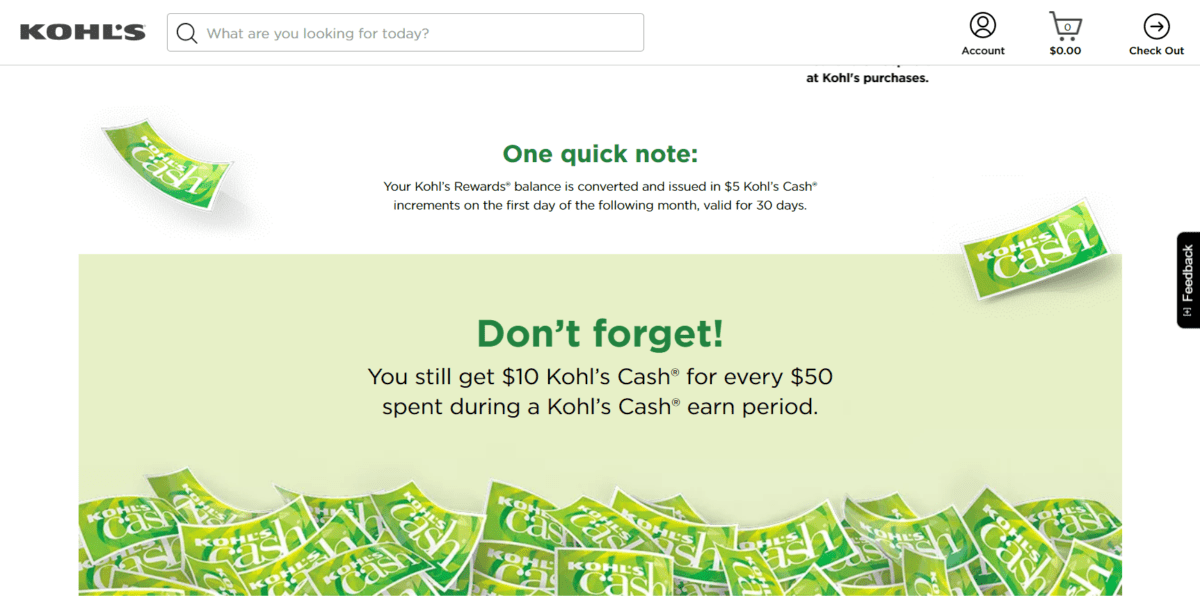
For example, the Kohl’s Rewards program gives customers 5% cash back for every purchase. Once they reach $5 or more in rewards, they’ll receive Kohl’s cash in $5 increments on the first day of the following month, valid for 30 days after issuance. Customers can use it in conjunction with any discounts available during the redemption period. Customers also get a special birthday gift, along with other discounts throughout the year.
Grow Your Audience With a Contest or Product Giveaway
Who doesn’t love free stuff? The concert or a giveaway is worth investing in if you want to build trust while boosting your sales effort.
Contests help build inbound links, which is a crucial part of SEO. They also show potential customers that your brand is trustworthy and serious about connecting.
You don’t have to launch with a massive contest or giveaway. You can do it on your own social media pages.

Benefit Cosmetics Canada ran an Instagram contest to give away a collection of products. To enter, people had to follow both Benefit Canada and The Kushie, like the post, and tag three friends. People could get a bonus entry by sharing the post in their stories and tagging the sponsoring brands.
Reach More Potential Customers with Free Samples
Sending free samples to influencers or offering free samples on your Facebook page and other social media channels can help you spread the word. It also gets your products directly in the hands of people interested in them. Once they’ve tried it, many will consider making a purchase.
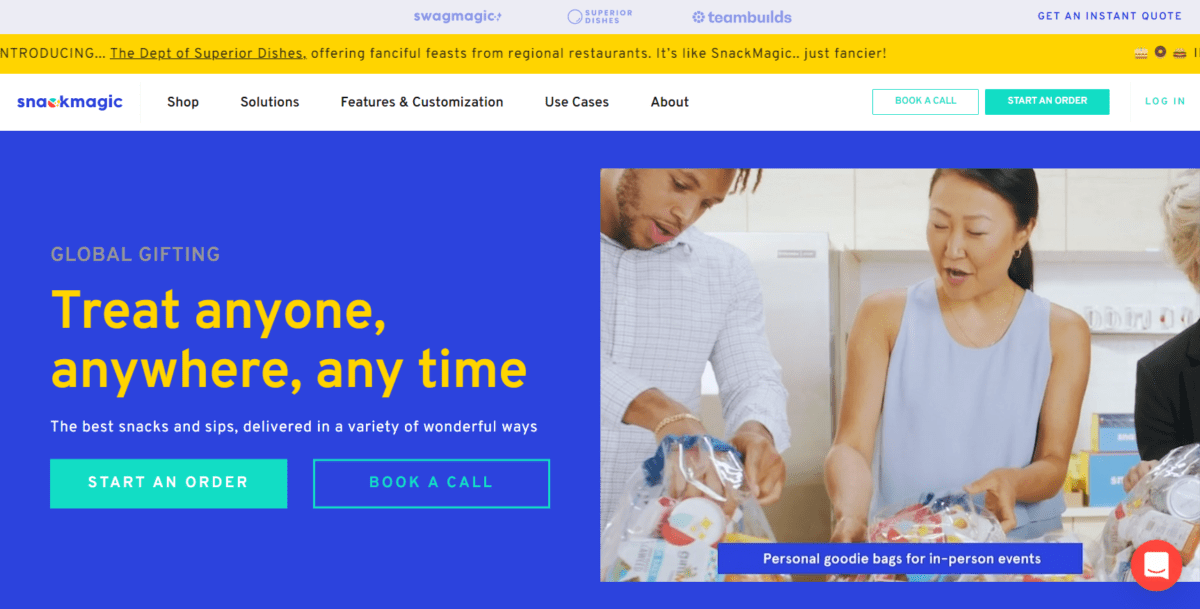
Food and beverage products could partner with a service like Snack Magic to get their products in the hands of consumers, too.
Reach Customers Everywhere with an Omni-Channel Strategy
With omnichannel marketing, you’ll be able to meet customers wherever they are to deliver the right messaging at the right time. It allows you to provide a unified customer experience across multiple touchpoints in the customer’s journey.
Using an omnichannel approach helps improve brand awareness and keeps your brand at the front of customers’ minds when they’re shopping. The key to success here is to think about your brand as a whole and not just the channel you’re working on. Customers need consistency across the board, or you’ll distort your brand image.
If a customer starts a purchase with you on a desktop, they should be able to finish that purchase from their mobile device with no friction. Make it as easy as possible for them no matter how and when they choose to engage with you.
Personalize the Customer Experience
Research shows 91% of customers are more likely to shop with businesses that give relevant offers and recommendations. When you consider this alongside the fact that 80% of customers are more likely to purchase from brands with personalized experiences and 72% of customers only engage with material customized specific to their interests, your business must personalize the experience to compete.
Personalizing the customer experience requires quality data and micro-segmentation. When it’s possible, leverage artificial intelligence to help you.
Spy on the Competition with Competitive Research
Competitive research is the process of identifying your competitors (both direct and indirect), evaluating their strengths and weaknesses, and the strengths and weaknesses of the products or services they offer.
It also involves researching their website to see the keywords they rank for and how well they rank.
With this information, you can create a strategy that makes it possible for you to compete, even against brands that have been in the market for a while.
Improve Campaign Results with Split Testing
Split-testing, also known as A/B testing, is crucial for success with marketing products online. You can use it to test the effectiveness of numerous campaign elements, including:
- Headlines/Subject lines
- Product descriptions
- Calls to action
- Offers
- Photos
- Layouts
To keep the tests clear, test one variable at a time, so you know what influenced the results. Run each test for as long as you can to get quality data.
Use the results to adjust your campaigns for better conversions and engagement.
Spread the News with Press Releases
One of the easiest ways to market a product online is with a press release. Though the strategy isn’t what it used to be, it is a great way to get media attention when done correctly.
For it to work, it has to be actually newsworthy news. If you’re not sharing something interesting for people to read about, you won’t get the results you want, resulting in wasted time and effort.
An excellent press release:
- Has a solid hook
- Features a compelling headline
- Skips industry jargon
- Provides additional resources
- Is free of grammar errors and typos
- Is short, concise, and follows a template
Invest in a press release distribution service to ensure it reaches a broad audience. If you’ve established relationships with influencers, email them a link. Share the press release on your social media account, as well.
Increase Trust with Social Proof and User-Generated Content
User-generated content, or UGC, like customer reviews, testimonials, social media posts, and case studies, are all forms of social proof. Social proof serves as the “wisdom of the crowd” and helps to convince people to buy.
Make it easy for people to share their experiences with your products or services. If you get negative reviews, respond to them kindly, apologize, and address the customer’s concern.
Sell Wholesale to Other Businesses for Another Income Stream
Selling to consumers is how many businesses operate, but opening your inventory to wholesalers could boost your cash flow. Yes, selling wholesale comes with a lower profit margin, but it can bring in more revenue at one time than waiting for consumer sales to trickle in.
Selling wholesale allows other companies to market for you and spread the word about your product. Wholesaling could indirectly improve your consumer sales.
Monitor Analytics to Find Successes
Install Google Analytics on your website if you haven’t already. It will provide a ton of data about your audience, how they find your website, the pages they visit, and how long they stay on your site. You can use this information to determine which of your paid ads are producing the most sales, which marketing channels are the most effective, and more.
Beyond Google Analytics, you can use other analytics tools, like the built-in options you’ll find on every social media platform. Use the data you find to decide when and how to make adjustments to your campaigns.
FAQs
What Marketing Strategies Will You Try First?
When it comes to selling things online, you not only need a steady stream of new customers but also keep current customers coming back for more.
If you have a budget, marketing products online is much easier than if you try to do everything for free. But if all you can do is start with a blog post here and there and share your content on your social media accounts – that’s better than no marketing at all.
Which of these methods will you add to your marketing strategy?
